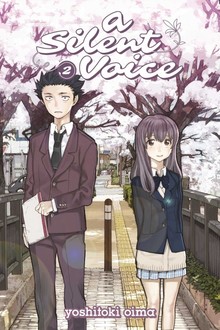Manga A Silent Voice & Haven’t You Heard? I’m Sakamoto Explore Bullying From Different Perspectives
Comics Features MangaThese stories often begin with the appearance of a mysterious transfer student.
An unknown new character suddenly interrupts the established classroom dynamic, providing an opportunity to shake things up—for good or for ill. The New Transfer Student Trope is used so often in Japanese media that when any incoming pupils appear, they’re immediately suspect of being an alien or supernatural creature, sent to spy on the human race or trigger a superhero’s awakening. But when none of those world-shattering events occur, we instead watch to see if the new student truly assimilates or not. If they don’t, they are usually singled out and targeted. They get bullied.
Themes of bullying play heavily into two different Japanese comics that just recently came out in English: Yoshitoki Oima’s A Silent Voice and Nami Sano’s Haven’t You Heard? I’m Sakamoto. The former deals with the heavy topic more seriously, while the latter goes over the top into humor. Each approach, however, has lessons to teach.
The most recognizable bullying trope in American media consists of a newcomer surrendering lunch money in lieu of getting beaten up. Alternatively, the Japanese schoolyard drama comics in my youth offered substantially different bullying techniques. Discerning if these cruelties have any basis in reality is difficult because I didn’t grow up in the Japanese school system, but I also haven’t personally known anyone shaken down for money while growing up in the American school system, either.
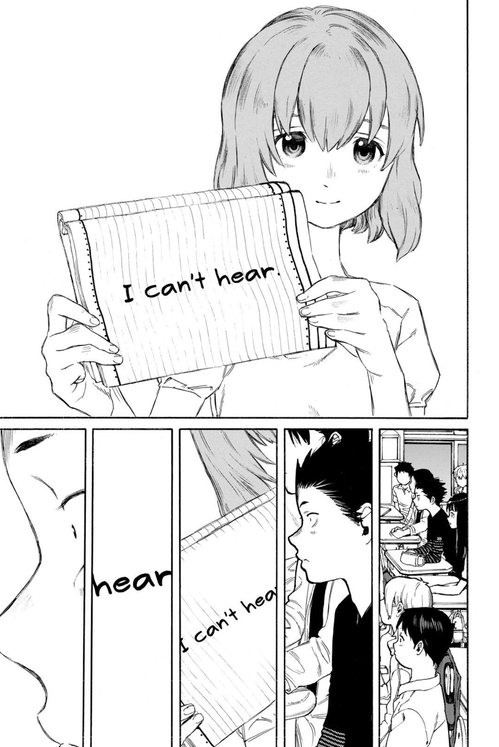
A Silent Voice Interior Art by Yoshitoki Oima
When reading manga, I notice harmless-seeming pranks involving the classroom’s sliding door and carefully placed erasers covered in chalk—great tools for soiling a boy’s pure black uniform. In America, we rarely install sliding doors in our schools, and chalkboards are all but nonexistent now, replaced by modern white-erase boards and markers. In these manga imports, a targeted student’s desk is often desecrated, transgressions ranging from written slurs or threats, to the perpetrators hiding the whole desk entirely. Growing up in America, I didn’t have an assigned desk and once got in trouble for doodling on one in pencil. While reading these books I began to wonder where the teachers are during all this.
A Silent Voice conveys a more realistic and believable account of bullying. Shoya Ishida is a sixth-grade boy who claims to be fighting a never-ending battle against boredom. After school, he regularly coerces his friends into jumping from bridge overpasses into canals, and he proudly claims that he agitated an older boy into beating him up. Though background familial conflict might explain such behavior, Shoya’s mother is a hardworking, independent businesswoman, running a hair salon out of her house. Shoya’s father does not appear in the series, and his significantly older sister is also largely absent—she pops up occasionally, but her face is perpetually obscured. Shoyo is generally liked by the rest of his grade as the entertaining class clown.
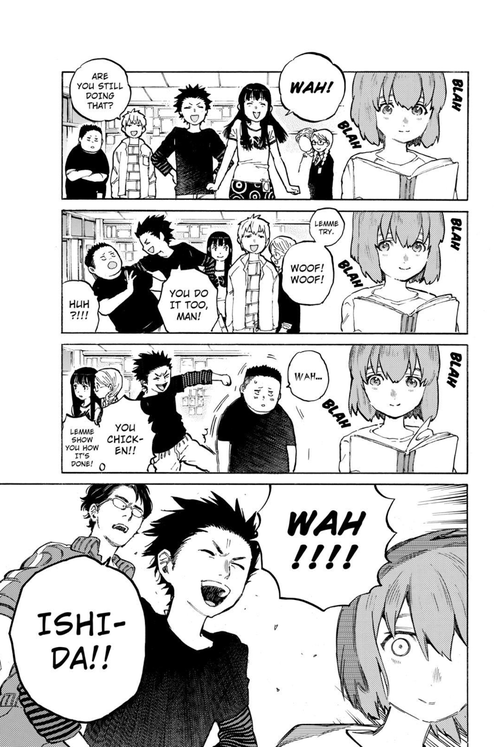
A Silent Voice Interior Art by Yoshitoki Oima
Then transfer student Shoko Nishimiya appears. She introduces herself in front of the entire class by holding up a notebook with handwriting on it, explaining she’s deaf and hopes to make friends by communicating through her journal. Shoya immediately calls Shoko a weirdo out loud, his subsequent prodding setting the bullying tone for the rest of the school year. When a girl in class attempts to learn sign language in order to try and communicate better with Shoko, the kind soul quickly backs off after other girls call her a teacher’s pet. Soon, the class expresses irritation with the concessions made to accommodate Shoko’s disability. This new tone encourages Shoya and his friends into more extreme behavior, such as stealing and destroying Shoko’s expensive hearing aids.
A Silent Voice’s story unfolds through a first-person perspective, the reader limited to the view of the bullying Shoya. Unable to see into Shoko’s thoughts and perceive how she deals with this torment, this design choice is initially disappointing. But the effect causes the reader to also feel how understanding between the victim and her bully has been severed. While reading, I became all the more eager for scenes in which Shoko communicates her feelings to Shoya. All this may sound like a super bummer, but A Silent Voice does have lighthearted elements, like when a scapegoated and older Shoya finally makes a new upbeat friend. I appreciate Yoshitoki Oima’s subtle facial expressions, which are hugely important in a comic where one of the main characters can’t talk.
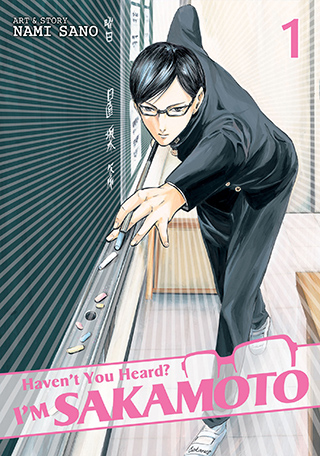
Haven’t You Heard? I’m Sakamoto Cover Art by Nami Sano
Haven’t You Heard? I’m Sakamoto takes tales of bullying and flips them on their head. Sakamoto is the Ferris Bueller type, conscious of and ultimately immune to all attempts to bring him down. Unflappable Sakamoto is a transfer student like Shoko, but he thrives in his new environment, growing his fan base at his new school while holdout cliques attempt to sabotage him. Like old kung-fu Wuxia fight scenes, in which enemies approach the hero one at a time, these bullies’ lack of a coordinated effort can’t win against Sakamoto’s smooth moves. They only prove to make him stronger, and the aggressors eventually fall for his charm.
In A Silent Voice, the reader initially follows the story from a single bully’s point of view, but in Haven’t You Heard? I’m Sakamoto, the camera peeks inside the thoughts of the new bullies featured in each chapter as they try to tussle with Sakamoto. Similar to Shoko, we never see inside victim Sakamoto’s thoughts. Since the reader rarely gets inside Sakamoto’s head, the manga makes it hard to tell if the vague comments he speaks out loud about humans being “an interesting species” should be taken at sci-fi face value, or if he’s actually just a weirdo. But our disconnect with Sakamoto’s motivations makes for good humor in this example, versus the misunderstandings in A Silent Voice.
Frank portrayals of bullying, like that shown in A Silent Voice, are a sensitive subject and are not without controversy. While Oima won a Best Rookie Manga award for the submitted one-shot version of A Silent Voice in 2008, it wasn’t actually published in any magazines until 2011, after legal disputes over its content. The full serialization that started in 2013 had the consultation and support from the Japanese Federation of the Deaf. Past incidents of highly-publicized suicides triggered by bullying have made the general Japanese public more aware of these issue and there have been calls for legislation. Accolades for A Silent Voice continue, and in 2015 it was one of nine nominees for the coveted Tezuka Osamu Cultural Prize, where it went on to win for in the New Creator/Originality Prize category.
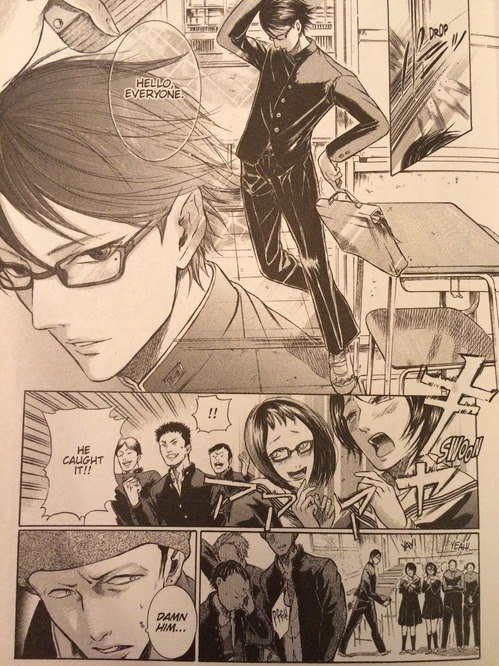
Haven’t You Heard? I’m Sakamoto Cover Art by Nami Sano
The story behind A Silent Voice is a long-fought road exploring the fallout of bullying and whether forgiveness can ever be achieved, while Haven’t You Heard? I’m Sakamoto lampoons typical Japanese bullying story tropes with disarming wit. Both series are worth exploring even if you don’t have any familiarity with the topics touched on, as both have approachable localizations and important social lessons that Western audiences can glean.
The first two volumes of A Silent Voice can currently be read digitally or in print, and are available through comiXology as well as Crunchyroll Manga. The first volume ofHaven’t You Heard? I’m Sakamoto is available only in print.
